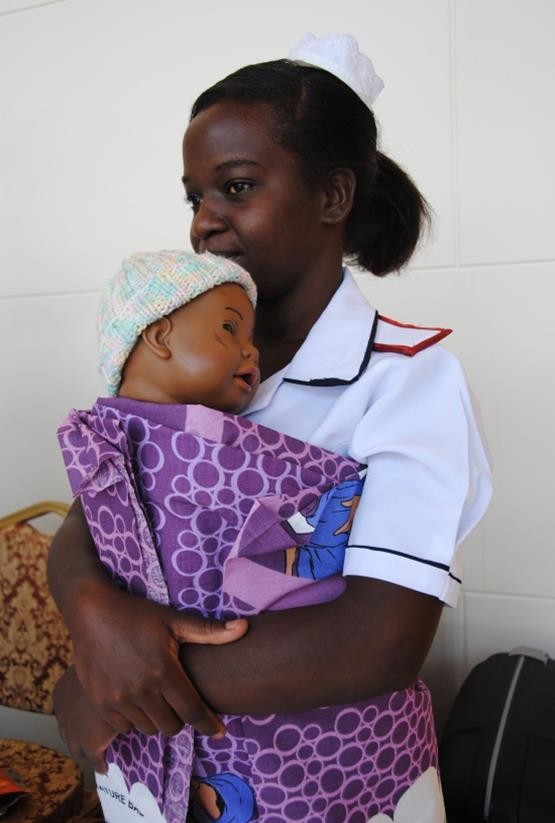
USAID/Malawi Communications Specialist Oris Chimenya Speaks To Christabel Namonde, Balaka District Coordinator For The USAID-Funded Project, Support For Service Delivery Integration (SSDI) Services On How Pre-Mature Babies Are Saved Through Kangaroo Mother Care (KMC):
1. Briefly tell us what the KMC process is.
Low birthweight is one of the main causes of death in neonates—a new born child, less than four weeks old. Kangaroo Mother Care (KMC) is a cost-effective, high-impact way of caring for low birthweight babies who are born premature. It is particularly suitable for resource-poor settings where there are no incubators, and problems with power are common.
KMC involves keeping the baby warm through skin-to-skin contact with the mother and also feeding the baby regularly using a schedule. (Regular feeding is important because premature babies cannot demand feedings like babies that are fully developed and die as a result.) In addition, the close contact with the mother promotes bonding which increases the likelihood of survival.
Under normal circumstances in Malawi, a baby is usually kept at the back of the mother. But in the KMC process, the baby is kept in front of the mother for easier and closer care of the baby by the one doing the KMC.
2. What is the incidence of prematurity in Balaka District?
41 out of 1000 live births in Balaka District are premature, which compares favourably with a national average of 180 out of every 1000 live births.
3. How were premature babies dealt with at Balaka District Hospital before the USAID-funded SSDI project started?
Before the SSDI-Services program started its interventions in Balaka, there were no KMC services at Balaka District Hospital. All premature babies were being referred to Comfort Health Clinic which used incubators to manage premature babies. Comfort Health Clinic is a Christian Health Association of Malawi (CHAM) health facility that is located 4 kilometers from Balaka district hospital.
4. How did the USAID-funded SSDI Project assist Balaka District Hospital with the Introduction of KMC?
When SSDI-Services began, Balaka District Hospital had no KMC services being offered in its maternity ward due to lack of capacity and space. To address this problem, SSDI-Services worked with the District Health Office (DHO) to develop a KMC program for the entire district. It began by training 25 nurses and clinicians and also trained 36 support staff to assist in monitoring the babies. A learning visit to Queen Elizabeth Central Hospital (Malawi’s biggest referral hospital) in Blantyre was organized for 17 staff members (nurses, clinicians and support staff).
At the District Hospital SSDI-Services supported the DHO to initially identify space within the postnatal ward and, later on, a separate spacious room dedicated for KMC. In order to strengthen KMC services in the district, SSDI-Services printed and provided the Ministry of Health (MOH) guidelines for managing low-birth-weight babies, heaters, weighing scales and feeding cups to help care for the premature babies. Registers to strengthen data capturing and documentation and training in supervision and mentoring were also provided.
Currently, Balaka District Hospital offers full KMC services, and KMC “Corners” have been established in all 11 facilities in the district supported by SSDI-Services. SSDI-Services has also supported and strengthened the involvement of Health Surveillance Assistants (HSAs) by orienting them in KMC provision in order to follow-up with KMC babies once they are discharged from the health facilities.
5. As SSDI, how have you worked with the Hospital to make sure that the KMC Ward is functional even when the project closes?
SSDI-Services has built the capacity and competencies of both facility-based technical and support staff and HSAs in the community through training, supervision and mentorship and has also ensured that KMC services are included in the District Implementation Plan so that there is continuity of care after the project phases out.
6. What would you say is the most significant result from KMC in Balaka?
The biggest achievement has been the significant reduction in the death rate amongst premature babies. It has reduced from 54 percent in 2012 to an average of one percent in 2016.
7. Any last words?
With support from USAID, the SSDI-Services project has managed to improve the quality of health service delivery. If not for this USAID-funded project, the deaths of premature babies in Balaka could still be as high as 54 percent.







Comment
Make a general inquiry or suggest an improvement.